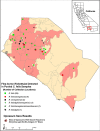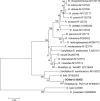Rickettsial Infections among Ctenocephalides felis and Host Animals during a Flea-Borne Rickettsioses Outbreak in Orange County, California
- PMID: 27537367
- PMCID: PMC4990410
- DOI: 10.1371/journal.pone.0160604
Rickettsial Infections among Ctenocephalides felis and Host Animals during a Flea-Borne Rickettsioses Outbreak in Orange County, California
Abstract
Due to a resurgence of flea-borne rickettsioses in Orange County, California, we investigated the etiologies of rickettsial infections of Ctenocephalides felis, the predominant fleas species obtained from opossums (Didelphis virginiana) and domestic cats (Felis catus), collected from case exposure sites and other areas in Orange County. In addition, we assessed the prevalence of IgG antibodies against spotted fever group (SFGR) and typhus group (TGR) rickettsiae in opossum sera. Of the 597 flea specimens collected from opossums and cats, 37.2% tested positive for Rickettsia. PCR and sequencing of rickettsial genes obtained from C. felis flea DNA preparations revealed the presence of R. typhi (1.3%), R. felis (28.0%) and R. felis-like organisms (7.5%). Sera from opossums contained TGR-specific (40.84%), but not SFGR-specific antibodies. The detection of R. felis and R. typhi in the C. felis fleas in Orange County highlights the potential risk for human infection with either of these pathogens, and underscores the need for further investigations incorporating specimens from humans, animal hosts, and invertebrate vectors in endemic areas. Such studies will be essential for establishing a link in the ongoing flea-borne rickettsioses outbreaks.
Conflict of interest statement
Figures


Similar articles
-
Rickettsial Infections among Cats and Cat Fleas in Riverside County, California.Am J Trop Med Hyg. 2018 Aug;99(2):291-296. doi: 10.4269/ajtmh.17-0706. Epub 2018 May 31. Am J Trop Med Hyg. 2018. PMID: 29869607 Free PMC article.
-
Detection of Rickettsia Species in Fleas Collected from Cats in Regions Endemic and Nonendemic for Flea-Borne Rickettsioses in California.Vector Borne Zoonotic Dis. 2016 Mar;16(3):151-6. doi: 10.1089/vbz.2015.1869. Epub 2016 Jan 29. Vector Borne Zoonotic Dis. 2016. PMID: 26824189
-
Rickettsia felis in cat fleas, Ctenocephalides felis parasitizing opossums, San Bernardino County, California.Med Vet Entomol. 2012 Dec;26(4):458-62. doi: 10.1111/j.1365-2915.2012.01017.x. Epub 2012 Jun 20. Med Vet Entomol. 2012. PMID: 22712460 Free PMC article.
-
Flea-borne rickettsioses: ecologic considerations.Emerg Infect Dis. 1997 Jul-Sep;3(3):319-27. doi: 10.3201/eid0303.970308. Emerg Infect Dis. 1997. PMID: 9284376 Free PMC article. Review.
-
Ecology of Rickettsia felis: a review.J Med Entomol. 2009 Jul;46(4):723-36. doi: 10.1603/033.046.0402. J Med Entomol. 2009. PMID: 19645274 Review.
Cited by
-
Rickettsia-Host-Tick Interactions: Knowledge Advances and Gaps.Infect Immun. 2022 Sep 15;90(9):e0062121. doi: 10.1128/iai.00621-21. Epub 2022 Aug 22. Infect Immun. 2022. PMID: 35993770 Free PMC article. Review.
-
Differential Rickettsial Transcription in Bloodfeeding and Non-Bloodfeeding Arthropod Hosts.PLoS One. 2016 Sep 23;11(9):e0163769. doi: 10.1371/journal.pone.0163769. eCollection 2016. PLoS One. 2016. PMID: 27662479 Free PMC article.
-
Murine Typhus: A Review of a Reemerging Flea-Borne Rickettsiosis with Potential for Neurologic Manifestations and Sequalae.Infect Dis Rep. 2023 Oct 26;15(6):700-716. doi: 10.3390/idr15060063. Infect Dis Rep. 2023. PMID: 37987401 Free PMC article. Review.
-
Analysis of Health-Care Charges in Murine Typhus: Need for Improved Clinical Recognition and Diagnostics for Acute Disease.Am J Trop Med Hyg. 2018 Jun;98(6):1594-1598. doi: 10.4269/ajtmh.17-0411. Epub 2018 Apr 5. Am J Trop Med Hyg. 2018. PMID: 29637877 Free PMC article.
-
Unpacking the intricacies of Rickettsia-vector interactions.Trends Parasitol. 2021 Aug;37(8):734-746. doi: 10.1016/j.pt.2021.05.008. Epub 2021 Jun 21. Trends Parasitol. 2021. PMID: 34162522 Free PMC article. Review.
References
-
- CDPH-VBDS. Vector-Borne Disease section, 2013 Annual Report. California Department of Public Health, 2014. http://www.cdph.ca.gov/programs/vbds/Documents/VBDSAnnualReport13.pdf
MeSH terms
Substances
Grants and funding
LinkOut - more resources
Full Text Sources
Other Literature Sources
Miscellaneous

